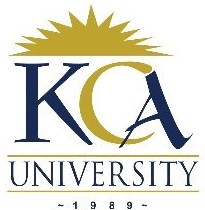
UNIVERSITY EXAMINATIONS: 2017/2018
EXAMINATION FOR THE DEGREE OF BACHELOR OF SCIENCE IN
INFORMATION TECHNOLOGY/ BACHELOR OF BUSINESS IN
INFORMATION TECHNOLOGY
BIT 2308: HUMAN COMPUTER INTERACTION
FULL TIME/PART TIME/DISTANCE LEARNING
DATE: DECEMBER, 2017 TIME: 2 HOURS
INSTRUCTIONS: Answer Question One & ANY OTHER TWO questions.
QUESTION ONE [30 MARKS]
a) Explain the meaning of visibility and affordance. [3Marks]
b) Describe, with the aid of a diagram, the Extended Human Information Processing model.
[6Marks]
c) A database entry screen is being designed. The screen will display a form consisting of a
large number of text boxes. The information to be entered will be in several categories,
including personal details, account details and transaction information.
Discuss ways in which the Gestalt Laws of Perceptual Organization could be applied to
enhance the usability of this screen. [6Marks]
d) Explain the way in which menus favour knowledge in the world over knowledge in the head.
[3Marks]
e) State the three principles that theoretically exist when applying Fitts’ law to interface designs.
[6Marks]
f) Compare the constructivist and ecological theories of perception and give examples of how
each has influenced interface design. [6Marks]
QUESTION TWO [20 MARKS]
(a) Explain the way in which schemata and scripts can guide the behaviour of a user, who is
experienced with a particular spreadsheet application, when interacting with a new,
unfamiliar spreadsheet application. [4Marks]
(b) Discuss the significance of the theory of mental models for interface design.
[6Marks]
(c) A fast food restaurant is planning to introduce a new computer system which will allow
customers to place orders from their tables.
(i) Justify the selection AND rejection of common types of input and output devices
for the system. [8Marks]
(ii) Explain the types of user support which might be required for the system.
[2Marks]
QUESTION THREE [20 MARKS]
a) Give any four data collection methods that are adopted during task analysis in human
computer interaction. [4Marks]
b) Briefly explain three characteristics of CSCW. [6Marks]
c) Describe the meaning of the term “groupware”. Give one example. [4Marks]
d) Describe the usability factors that are considered when designing a usable system.
[6Marks]
QUESTION FOUR [20 MARKS]
a) Briefly explain any four principles that should be followed when designing icons
[4Marks]
b) Distinguish between command line interface and menu based interface. Give one advantage
for each of them. [4Marks]
c) One of the techniques used in the usability life cycle is task analysis. In relation to task
analysis, explain the concept of GOMS. [6Marks]
d) Describe three types of user support that can be provided to a user during human computer
interaction [6Marks]
QUESTION FIVE [20 MARKS]
a) Briefly explain any four principles that should be followed when designing icons.
[4Marks]
b) A number of advocates of user-centered design have presented sets of ‘golden rules’ or
heuristics. While these are inevitably ‘broad-brush’ design rules, which may not always be
applicable to every situation, they do provide a useful checklist or summary of the essence of
design advice. It is clear that any designer following even these simple rules will produce a
better system than one who ignores them.
(i) Explain briefly any five of Norman’s Principles for transforming difficult tasks
into simple ones. [5Marks]
(ii) Explain briefly any five of the Shneiderman’s Golden rules for dialogue design.
[5Marks]
c) Metaphors convey an abstract concept in a more familiar and accessible form. The desktop
metaphor has been used successfully for operating systems. However, other metaphors have
been developed for specific types of applications. With the aid of relevant examples of
application areas and familiar knowledge, state any six of these metaphors.
[6Marks]
